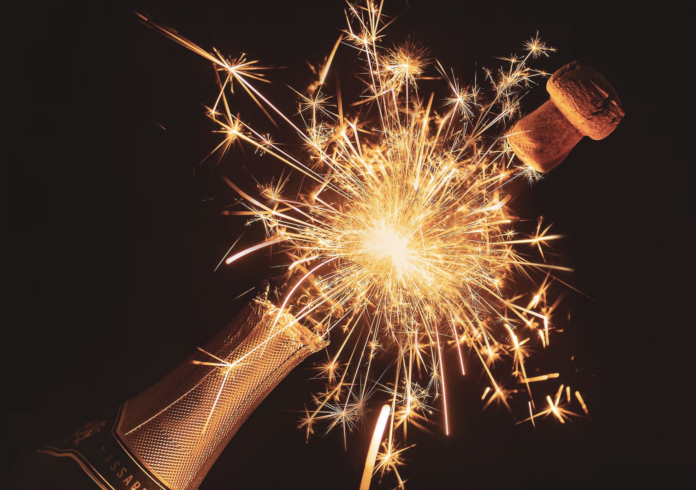Suzanne Goin and Caroline Styne, A.O.C. Third Street and Brentwood, California locations
A.O.C. celebrates the arrival of 2023 with a multi-course New Year’s Eve menu of small plates and platters created by Suzanne Goin, using the best seasonal produce from California farmers and designed for sharing.
With a great variety of dishes offered, highlights of A.O.C.’s New Year’s menu Starters section include: American Caviar with Buckwheat Blinis, red onion crème fraîche & brown butter; Endive with Little Gems, apples, anchovy cream & monte enebro; Beet Tartare with Fuerte Avocado, cucumber, pepitas & crème fraîche; Dungeness Crab Fritters with patatas bravas & romesco; focaccia: kabocha squash, taleggio, linda’s watercress & black truffle vinaigrette; and New Year’s Vintner’s Plate—cheese, meats, pickles & purées (for 2 —vegetarian version available)
and Then…choose…
Spanish Fried Chicken with romesco aïoli & chile-cumin butter; Balsamic-Glazed Brussels Sprouts with burrata, radicchio & toasted crumbs; Italian Broccoli and Rapini with green harissa & douro almond dukkah; Diver Scallops with Fennel-Endive Salad, pistachios & pomelo salsa; Oven-Roasted Manila Clams with sherry & green garlic; and Squid Ink Gnocchi With Prawns, toasted garlic & young spinach.
Next up is More Good Stuff, including…
Soft Polenta with Wild Mushrooms, mascarpone & swiss chard; Wood-Grilled Carrots with Jeweled Rice, pomegranate & aleppo; Bluenose Bass with Scallion Soubise, winter citrus & green olives; Grilled Seabream with Red Kuri Purée, golden raisins & pedro jimenez brown butter; Lamb Chops with Flageolet Gratin, roasted radicchio & black olive tapenade; Veal Cheeks with Risotto Carbonara, mustard greens & meyer lemon; Hanger Steak with Red Wine Butter, young turnips & their greens; and the signature Roasted Chicken “Ode To Zuni”—panzanella, fennel & green olives (for two)
For Dessert, there is a…
Three Cheese Plate, accompaniments & a.o.c. boule; Salted Caramel Panna Cotta, pecan praline & roasted apples; Crème Fraîche Cheesecake with blood orange curd & winter citrus; and the quintessential Chocolates & Confections (for 2).
Pricing is $155 per guest, exclusive of beverages, taxes, gratuity and complimentary sparkling toast. Wine pairings selected by Caroline Styne are offered at a $50 supplemental charge to complement the menu. For those dining spontaneously, guests can dine on an à la carte menu at the communal table or bar without a reservation, as space allows.
Don’t miss Head Bar Man Ignacio Murillo’s seasonal cocktails – a must-try for the holiday season – A.O.C.’s proprietary Eggnog with Aged Rum, bourbon, maple & winter spices; Red Angel with Ford’s Gin, pomegranate juice, lemon & fennel; The Sunshine with Tequila Blanco, golden beet liqueur, orange, lime & árbol chile; Smoke & Passion with Mezcal, passion fruit, coconut & lime; Bartlett Sour with Bourbon, Poached Pear, lemon & house orgeat; Toki Old Fashioned with Suntory Whisky Toki, allspice dram & pecan bitters; and the signature Green Goddess with green tea-infused vodka, cucumber, arugula, jalapeño & absinthe rinse.
A.O.C. is open for Christmas Eve, Saturday, December 24, 2022, serving their traditional menu at both locations.
The restaurants are closed Christmas Day and New Year’s Day.
Reservations for New Year’s Eve are offered from 5:30 p.m. and can be booked online at www.aocwinebar.com, OpenTable.com, or by calling the restaurants.
Happy New Year
Welcome to 2023!
please choose one dish from each section
to start:
american caviar, buckwheat blinis, red onion crème fraîche & brown butter
endive, little gems, apples, anchovy cream & monte enebro
beet tartare, fuerte avocado, cucumber, pepitas & crème fraîche
dungeness crab fritters, patatas bravas & romesco
focaccia: kabocha squash, taleggio, linda’s watercress & black truffle vinaigrette
new year’s vintner’s plate—cheese, meats, pickles & purées (for 2 —vegetarian version available)
and then:
spanish fried chicken, romesco aïoli & chile-cumin butter
balsamic-glazed brussels sprouts, burrata, radicchio & toasted crumbs
italian broccoli, rapini, green harissa & douro almond dukkah
diver scallops, fennel-endive salad, pistachios & pomelo salsa
oven-roasted manila clams, sherry & green garlic
squid ink gnocchi, prawns, toasted garlic & young spinach
more good stuff:
soft polenta, wild mushrooms, mascarpone & swiss chard
wood-grilled carrots, jeweled rice, pomegranate & aleppo
bluenose bass, scallion soubise, winter citrus & green olives
grilled seabream, red kuri purée, golden raisins & pedro jimenez brown butter
lamb chops, flageolet gratin, roasted radicchio & black olive tapenade
veal cheeks, risotto carbonara, mustard greens & meyer lemon
hanger steak, red wine butter, young turnips & their greens
roasted chicken “ode to zuni”—panzanella, fennel & green olives (for two)
and finally…
three cheese plate, accompaniments & a.o.c. boule
salted caramel panna cotta, pecan praline & roasted apples
crème fraîche cheesecake, blood orange curd & winter citrus
chocolates & confections
WHEN:
A.O.C. 3rd Street
NEW YEAR’S EVE – SATURDAY, DECEMBER 31, 2022
Dinner reservations from 5:30 p.m.
$155 per guest; includes toast and party favors. Credit cards required to reserve.
Book online at www.aocwinebar.com, OpenTable.com, or by calling the restaurants.
Closed New Year’s Day, Saturday, January 1, 2023
A.O.C. in Brentwood
NEW YEAR’S EVE – SATURDAY, DECEMBER 31, 2022
Dinner reservations from 5:30 p.m.
$155 per guest; includes toast and party favors. Credit cards required to reserve.
Book online at www.aocwinebar.com, OpenTable.com ,or by calling the restaurants.
Closed New Year’s Day, Sunday, January 1, 2023




